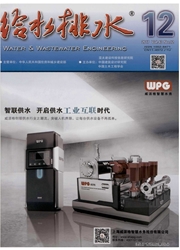

 中文摘要:
中文摘要:
以上海某自来水厂设计规模为7500m^3/d的臭氧/生物活性炭示范工程(预臭章∥高密度澄清池/砂滤/后臭氧/生物活性炭滤池)为研究背景,考察不同预臭氧投量下常规工艺对微污染黄浦江原水的处理效果。通过考察不同预臭氧投量下澄清池、砂滤工艺对浊度、DOC、CODM。UV254等指标的去除效果,以确定最优的预臭氧投量。结果表明,单独砂滤及澄清池对CODMn、DOC及UV佩基本没有去除效果,但预臭氧化工艺能强化常规工艺对这些指标的去除。预臭氧对原水中亚硝酸盐氮的去除效果较好,当水力负荷分别为2000和6000m^3/d,预臭氧投量为1.5mg/L时,工艺出水浊度均低于0.1NTU。
 英文摘要:
英文摘要:
Based on a 7 500 m^2/d demonstration project using pre-ozonation, high density clarifier, sand filter, post-ozonation and biological activated carbon filter at a waterworks in Shanghai, the effect of different pre-ozone doses on the conventional treatment processes of raw water from the Huangpu River was investigated. The turbidity, DOC, CODMn and UV2s4 of the effluent from the clarifier and the sand filters were evaluated to determine an optimal pre-ozone dose. Both the clarifier and the sand filter had no effect on the removal of DOC, CODMn and UV254, but the pre-ozonation could enhance the removal of these indexes in the conventional treatment processes. The nitrite in raw water was effectively removed by pre-ozonation. When the pre-ozone dose was 1.5 mg/L, the turbidity of the effluent was below 0.1 NTU at hydraulic loading rates of 2 000 m^3/d and 6 000 m^3/d.
 同期刊论文项目
同期刊论文项目
 同项目期刊论文
同项目期刊论文
 Phosphorus bioavailability in a phosphorus-abundant system under repeated sediment resuspension cond
Phosphorus bioavailability in a phosphorus-abundant system under repeated sediment resuspension cond Contributions of phosphorus on sedimentary phosphorus bioavailability under sediment resuspension co
Contributions of phosphorus on sedimentary phosphorus bioavailability under sediment resuspension co 期刊信息
期刊信息
